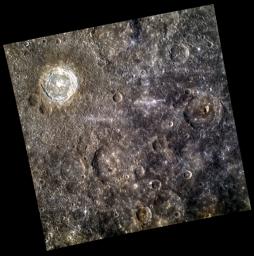In the upper left hand corner, Balzac crater's bright central peak and wall slumps make it the highlight of this image. Also, one can easily see the difference between Balzac's ejecta blanket and the surrounding terrain through the appearance of crater chains and color differences. In addition, Low Reflectance Material (LRM) is visible in the lower right hand corner, and an interesting pit-floor crater is visible on the right.
This image was acquired as part of MDIS's high-resolution 3-color imaging campaign. The 3-color campaign is a major mapping activity in MESSENGER's extended mission. It complements the 8-color base map (at an average resolution of 1 km/pixel) acquired during MESSENGER's primary mission by imaging Mercury's surface in a subset of the color filters at the highest resolution possible. The three narrow-band color filters are centered at wavelengths of 430 nm, 750 nm, and 1000 nm, and image resolutions generally range from 100 to 400 meters/pixel in the northern hemisphere.
Date acquired: June 07, 2012
Image Mission Elapsed Time (MET): 247596719, 247596711, 247596715
Image ID: 1973908, 1973906, 1973907
Instrument: Wide Angle Camera (WAC) of the Mercury Dual Imaging System (MDIS)
WAC filters: 9, 7, 6 (996, 748, 433 nanometers) in red, green, and blue
Center Latitude: 8.55°
Center Longitude: 218.6° E
Resolution: 409 meters/pixel
Scale: Balzac crater is ~67 km (~42 miles) in diameter.
Incidence Angle: 40.6°
Emission Angle: 0.4°
Phase Angle: 40.9°
The MESSENGER spacecraft is the first ever to orbit the planet Mercury, and the spacecraft's seven scientific instruments and radio science investigation are unraveling the history and evolution of the Solar System's innermost planet. Visit the Why Mercury? section of this website to learn more about the key science questions that the MESSENGER mission is addressing. During the one-year primary mission, MDIS acquired 88,746 images and extensive other data sets. MESSENGER is now in a year-long extended mission, during which plans call for the acquisition of more than 80,000 additional images to support MESSENGER's science goals.
These images are from MESSENGER, a NASA Discovery mission to conduct the first orbital study of the innermost planet, Mercury. For information regarding the use of images, see the MESSENGER image use policy.

 Planetary Data System
Planetary Data System












